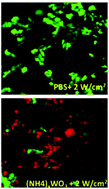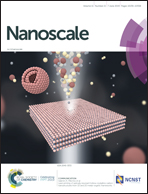PEGylated (NH4)xWO3 nanorod mediated rapid photonecrosis of breast cancer cells
Abstract
Photothermal therapy has emerged as a potential minimally invasive technique to destroy malignant cells with high selectivity. It utilizes low band gap nanoscale materials as photothermal agents dispersed at the affected area to increase the temperature locally by absorbing radiation in the near infrared (NIR) region and destroys the cells. In an effort to develop a photothermal agent with high efficacy for photothermal therapy, we found that (NH4)xWO3 nanorods of length 0.5–1.0 μm and diameter ∼100 nm could destroy breast cancer cells rapidly when irradiated with a wavelength in the therapeutic window. The material was prepared using a solvothermal route followed by PEGylation for improving the biocompatibility. X-ray diffraction and transmission electron microscopy studies revealed the hexagonal crystal lattice of the material. The uniform wrapping of polyethylene glycol (PEG) around the nanorods was confirmed using energy dispersive spectroscopy elemental mapping. An 808 nm laser was used to investigate the photothermal responses of the material on SUM-159 and MCF-7 breast cancer cells in vitro. The PEGylated-(NH4)xWO3 nanorods exhibited rapid temperature elevation from 20 °C to 60 °C within 3 min upon irradiation. A significant growth inhibition of SUM-159 and MCF-7 breast cancer cells with photonecrosis was observed. PEGylated (NH4)xWO3 nanorods could potentially be used in cancer therapy due to their strong photonecrotic properties at specific NIR wavelengths that suffer from minimal attenuation while passing through biological tissues.



 Please wait while we load your content...
Please wait while we load your content...